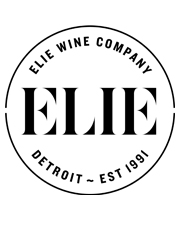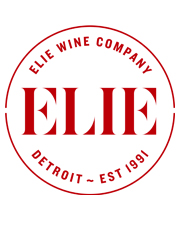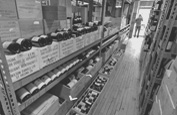Hard Cidre is Built for The Heat: Light-bodied, Agile, Versatile and Low in Alcohol, Whether Sparkling or Still. 6-Bottle Pack for $129 (750 ml) ‘Amour’ – By the Dozen $99 (330-ml Bottles)
According to the ‘superstore’ timetable, once the Fourth of July is in the can, it’s time for us to start buying Halloween decorations. While we prefer to avoid feeding the retail rascal before its time, there is one beverage typically associated with autumn that is also perfectly appropriate for a summery, sweltering evening.
Fermented apple cider, a staple brew of our Founding Fathers, once filled a vital drink gap in regions too damp to grow beer barley and too cold to grow wine grapes, and chances are good that the signing of the Declaration of Independence was accompanied by plenty of toasts with cider.
In France, whose own revolution followed close on the heels of our own, ‘cidre’ is the trademarked term for fermented cider from Normandy and Brittany; it is generally effervescent and contains about 3–5 percent alcohol. Sweetness varies; although it is mainly produced dry (Brut), the sweeter style (Doux) has its fans. Due to longer, more complete fermentation, Brut cidre is generally on the higher end of the ABV scale.
Despite Its Ties to Fall, Hard Cidre Screams Summertime Sipper
Low in octane, effervescent, quaffable and refreshing, cidre offers a great alternative to beer for your outdoor summer tipple. At its most basic, it is fermented apple juice—you can make it yourself with a gallon from the orchard and a pinch of baker’s yeast. But like wine, it appears in multiple guises—tart, sweet, bitter, herbaceous, full of fireworks sparkles like a Roman candle or gently effervescent. The idea that cidre is one dimensional is not borne of experience, but of one-dimensional palates.
A plus for cidre’s place on the summertime table is its food-friendly versatility. Cidre’s acidity and tannin makes it the ideal foil for the grill or smoker—ribs, obviously (pork and apples have an innate affinity)—but virtually any sizzling, fatty cut of flesh will be complimented, and also roasted vegetables—the rootier the better. Cheese is another classic matchup for cidre, and Normandy is as known for its fromage as it is for its apples.
Once a standby in American taverns, the end of Prohibition in 1933 put a permanent dent in the American hard cider industry. Orchards were cut down and replaced by new varieties of sweet, table apples, and it was not until the 1990s that artisan cider makers began to rediscover their red, white and blue heritage.
Of course, France’s flag is also red, white and blue, and diverse cidres offered in this week’s package reflect the diversity from the most heralded ‘cidre centre’ in France; Normandy.
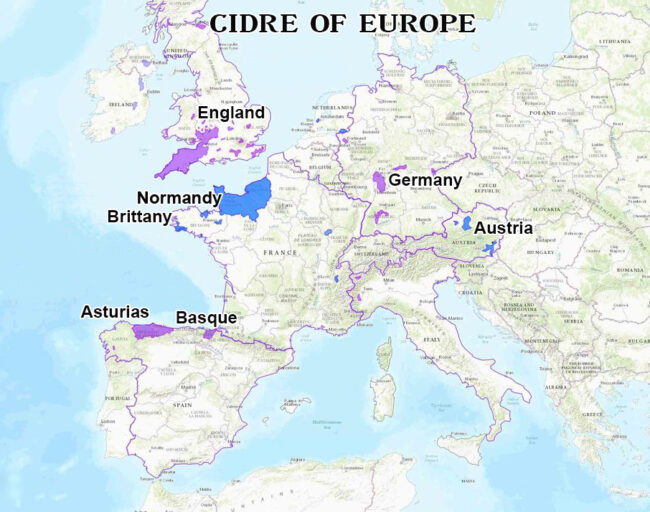
Styles: French Cidre Moves Beyond the Apple.
Keeving is Believing: Cidre relies on bittersweet and bittersharp apples rich in pectins and tannins and low in acid. As such, production tends to be a farmhouse undertaking and the art of cidre-making involves a filtering process known as keeving; keeving allows the natural pectin of the apples turn to a jelly-like consistency in cold temperatures over a week, where it rises to the top of the fermentation vessel as the heavy solids filter to the bottom of the tank and the jelly at the top. The remaining juice in the middle of the tank is then slowly fermented at cold temperatures with small quantities of yeast for 3-6 months.
The carbonation may be the result of a Champagne-like process or the artificial introduction of carbon dioxide at bottling.
Cidre de Normandie IGP was formalized in the year 2000; the cider must be made from apples, or a combination of apples and pears, each with its own profile and identity, giving cidre the same sort of unique varietal personality as wine has based on grapes.
Sweetness levels vary from dry to sweet (doux), and color from pale yellow to dark orange or rosé. There are also various technical specifications, including those regarding the types of apple or pear used. Tannin and acidity levels are also regulated. Many regulations vary depending on the category of fruit used, and the style of cider. Sweet ciders must have a minimum of 3.0 percent abv, while drier styles must reach 5.0 percent abv, or 5.5 percent for Cidre Bouché.
And then there is poiré, made from pears only; it differs from generic pear cider in that it’s made from designated varieties grown in Normandy. Pears are thought to have been grown here even before apple trees were cultivated.
Terroir: Cidre Takes Its Cue from Wine.
When fifteenth century Cistercian monks in Burgundy first began to document the difference in wine quality from various vineyards, they believed that it was a sign from above; that terroir expressed the variegated contours of God’s creation. Although in the modern era, the science of fermentation and a winemaker’s skill in applying and refined production methods have supplanted a monastic explanation for the differences in wine, the quest for a ‘sense of place’ remains alive and well.
In cider production—especially when compared to wine—terroir has traditionally had a less firm hold on the thought processes. For most of the world, cider is a year-long industrial manufacturing process, while in France, especially in controlled appellations, cidre is typically made seasonally, following the apple harvest. But like wine from grapes, cidre can be redolent not only of the fruit used, but of the locality where it’s grown; the soil, the aspect, the geography and the climate of the orchards.
This is precisely what winemakers call terroir.
L’AOC (controlled designation of origin laws) ensures that the product comes from a specified geographical area and is fermented accordingly to a specific savoir-faire. For cidre, there currently four AOCs: Cornouaille, Cotentin, Pays d’Auge. Domfront (for perry; cidre made from pears). Du Perche, a region in lower Normandy about ninety minutes from Paris, is currently awaiting final AOC status.
Cidre in Normandy: The Apple of the Region’s Eye!
Normandy, which most of us associate with the D-Day invasion of 1944, gets a failing grade in being French: They tend to love Americans. They also love apples, and harvest nearly half a million a year, many (but not all) destined to be transformed into Norman Cidre. Throughout the regions of Calvados, Eure, Manche, Orne and Seine-Maritime, cidre is king, although the menu also includes world-class apple juice, pectin jelly and phenomenal apple-based pastries. In the 9th century, Charlemagne ordered more apple trees to be planted in the region, which is too far north and too sunshine-challenged for grape cultivation.
The Norman apple harvest begins in mid-September, when ripe fruit begins to fall from trees naturally. More than 200 varieties of apples are legally permitted; the most common is the Frequin Rouge, followed by distinctive Michelin and Muscadet de Dieppe.
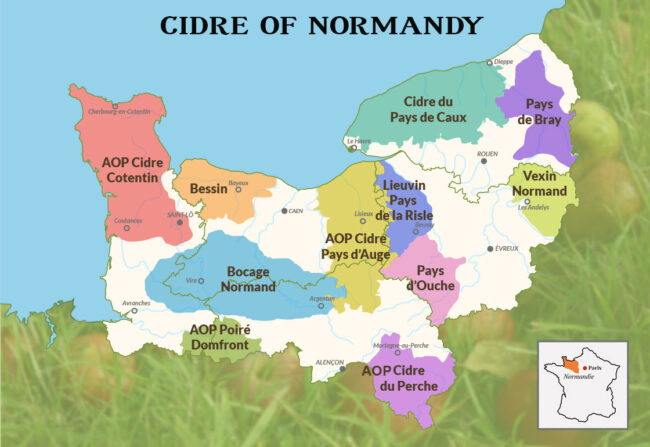
Marie-Agnès Hérout
Maison Hérout
The Contenin Peninsula, part of the staging area for Operation Overlord (the codename of the Invasion of Normandy) pokes its nose far into the English Channel, and was chosen as a landing site for this very reason. Maison Hérout, known for producing some of the driest and most complex ciders made anywhere, has seen many such incursions—the Hérout family tree goes back to the Vikings, who settled in this area around the ninth and tenth centuries. In fact, many Cotentin village names in the still flaunt Norse roots, like the beautiful Briquebec and Quettetot.
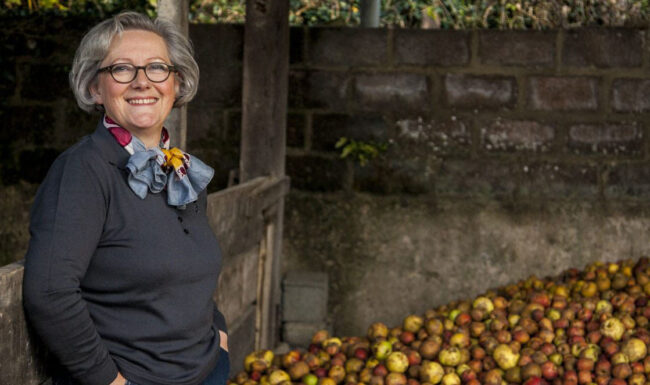
Marie-Agnès Hérout, Maison Hérout
© Hérout Cidres & Calvados
The Hérout estate is located near the town of Auvers, where apples thrive in a lush oceanic climate. The Hérout family began producing cider in the 1940s; today, Marie-Agnès Hérout has taken over the farm and remains true to her heritage by producing some of the finest ciders available from this region. After picking, the apples are grated, macerated, and then pressed with the help of a rack press dating back to 1920, whereupon the juice is left to ferment for four to seven months, often in used Calvados barrels.
Marie-Agnès also continues the family tradition of planting apple trees for future generations and in 2000, began a campaign with the Syndicat de Promotion du Cidre du Cotentin to earn the region’s certification for Appellation d’Origine Contrôlée Cotentin status. In May of 2016, after 16 years of hard work and perseverance, the quest succeeded.
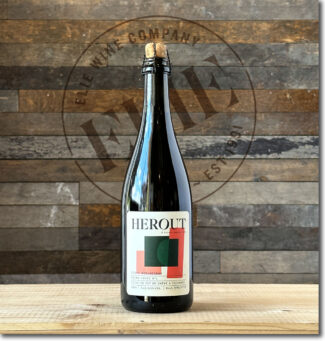 1 Maison Hérout ‘Micro – Cuvée No 1’, 2019 AOP Cotentin ($23) (750 ml, Effervescent Brut – Cidre Bio 6.5% abv)
1 Maison Hérout ‘Micro – Cuvée No 1’, 2019 AOP Cotentin ($23) (750 ml, Effervescent Brut – Cidre Bio 6.5% abv)
A fizzy, bright gold organic cidre aged for three months in Calvados barrels (leading to the slightly higher alcohol content). It shows aromas of fallen lemon and earth with a lightly tannic, vibrant and compelling body that shows brisk dried peach, hay and parchment on the finish.
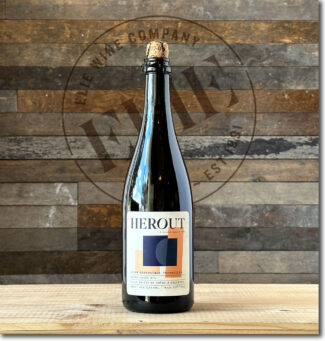 2 Maison Hérout ‘Micro – Cuvée No 1’, 2020 AOP Cotentin ($23) (750 ml, Tranquil – Cidre Bio 5.5% abv)
2 Maison Hérout ‘Micro – Cuvée No 1’, 2020 AOP Cotentin ($23) (750 ml, Tranquil – Cidre Bio 5.5% abv)
A still version of the above, made as an experiment that proved to be a widely popular success. Aged for 3 months in barrels that previously held Calvados.
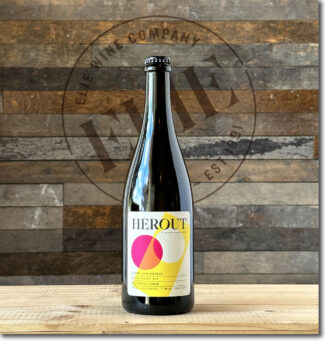 3 Maison Hérout ‘Micro – Cuvée No 4’, 2020 AOP Cotentin ($23) (750 ml, Effervescent – Cidre Bio 4% abv)
3 Maison Hérout ‘Micro – Cuvée No 4’, 2020 AOP Cotentin ($23) (750 ml, Effervescent – Cidre Bio 4% abv)
No. 4 a new cuvée produced entirely from rare acidic apples grown in the Contentinois orchards with no addition of bitter or sweet apples. It is barrel-aged for several months before the ‘prise de mousse’ captures the sparkle. Notes of rich apple must, orange, honey, leather, and earth lead to a tannic, slightly bitter finish. Only 9 cases available.
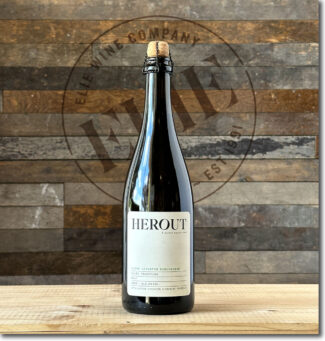 4 Maison Hérout ‘Cuvée Tradition’, 2020 AOP Cotentin ($18) (750 ml, Effervescent – Cidre Bio 5% abv)
4 Maison Hérout ‘Cuvée Tradition’, 2020 AOP Cotentin ($18) (750 ml, Effervescent – Cidre Bio 5% abv)
Bright gold color. Frothy bubbles. Aromas of picked apple. Slightly earthy with a tannic, vibrant, fruity light-to-medium body and compelling hints of minerality.
‘Amour’
By the Dozen ($99)
Cidre with a heart of gold, produced in the Cotentin Peninsula using artisanal techniques perfected by Maison Hérout since 1946—show the love by picking up a case, 12 of 330 ml bottles.
This is a good time for a shout out to our cidre importer Jon-David Headrick, whose rural Tennessee roots give him a particularly keen palate for apple cider while his many years in France have taught him how to uncork the best.
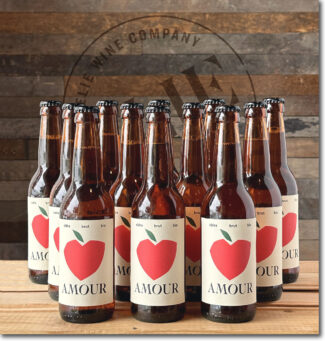 Maison Hérout ‘Amour’, IGP Cidre de Normandie – 4.5% abv – (330 ml)
Maison Hérout ‘Amour’, IGP Cidre de Normandie – 4.5% abv – (330 ml)
This is the only non-AOP cidre made by Hérout; it includes fruit that originates just outside the appellation and is exclusively bottled in 330 ml bottles. The juice is aged in a tank and bottled after about four months. Organic and slightly off-dry with the second fermentation occurring in the bottle; the cidre has an appealing low alcohol content. It is redolent of ripe apples in pastry, with hints of orange citrus, forest floor, bitter coffee bean and apricot on the finish.
Cyril Zangs
Cyril Zangs
Jazz-aficionado Cyril Zangs was a book sales rep in Paris before returning to his native Normandy and jumping into the cidre game with both feet. Of the 200 apple varieties approved for cidre making, he uses 69 of them, and in keeping with the natural wine movement, he ferments on native yeasts, unfiltered and without added sulphur.
After apple quality, Zangs says, it is all about process: “Each of our varieties possesses a particular characteristic (sweet, bittersweet, bitter, slightly acidic or sour) and are harvested from high-stem orchards which range from fifteen to sixty years old. We harvest by hand between early October and mid-December, when apples are the ripest. Our manual selection process ensures that only the best apples are picked—we then separate the apples by variety and store them in our barns to continue ripening for up to six weeks.”
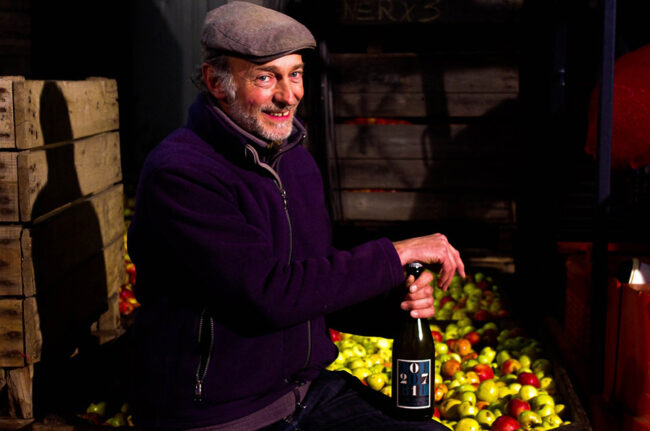
Cyril Zangs
What happens next? In his own words: “Once sorted to obtain the best flavor balance, the apples are grated to create a marc. This is put through to our hydraulic press and the juice is transferred to vats, and racked during the 6 months long fermentation process. It is left undisturbed apart from infrequent racking, or ‘soutirages’. The unfiltered cidre is bottled with no sulfites added and stocked horizontally for two to three months to capture the sparkle. The bottles are then stored on A-racks and regularly turned for three weeks; we then disgorge every bottle by hand, a process that naturally removes the sediment. Each bottle is topped up with the same disgorged cider, with nothing else added.”
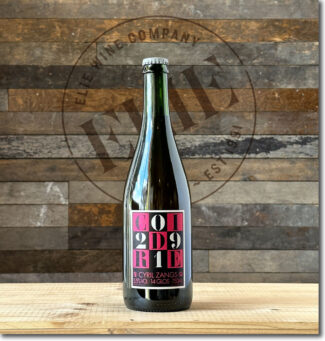 5 Cyril Zangs ’14 Glos’, 2019 IGP Cidre de Normandie ($27) (750 ml, Effervescent Brut – Cidre Bio 5.5% abv)
5 Cyril Zangs ’14 Glos’, 2019 IGP Cidre de Normandie ($27) (750 ml, Effervescent Brut – Cidre Bio 5.5% abv)
From the tiny commune of Glos in Calvados, Cyril Zangs produces this IGP cidre—IGP, for reference, is an EU quality classification that became valid in 2009; it means Indication Géographique Protégée and supplanted Vin de Pays. ‘14 Glos’ shows a creamy and rich texture, and displays notes of star anise, orange peel and unsurprisingly, bittersweet apple.
Guillaume & Thierry Desfrièches
Cidrerie Léon Desfrièches et Fils
‘Le Père Jules’
“In 1923, my father distilled his first Calvados”, says Léon Desfrièches, current head of the Desfrièches clan, and who has (since 1949) carried on the cidre and distilling traditions put in place by ‘Père Jules.’ In 1976, Léon’s eldest son Thierry joined him, followed by Guillaume, Thierry’s son, in 2002. Jules, Léon, Thierry and Guillaume—four generations of Desfrièches.
The Le Père Jules farm, Clos de la Pommeraye is made of a number of orchards spread over one hundred acres, with ten acres of pear trees. Extensive production is based on a with a tree density of around 80 to 100 trees per hectare.
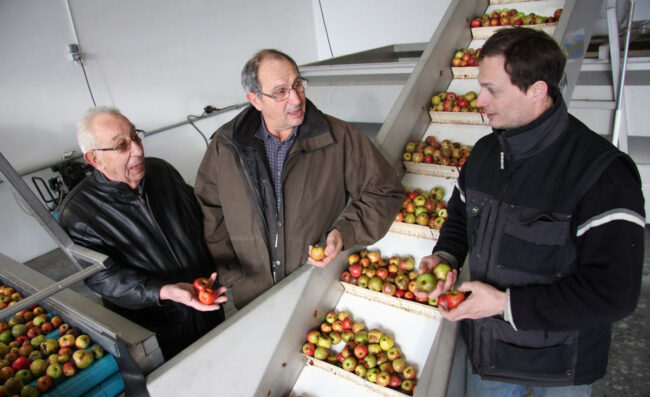
Léon, Thierry & Guillaume Desfrièches, Cidrerie Léon Desfrièches et Fils
Located in the Norman village of Saint Desir, the flagship cidre is made in honor of the late patriarch Jules. Now 85, Léon says: “I would have really liked my father sees what we have accomplished. As for myself, I hope I am like my Calvados: Serene and not afraid of aging with elegance, grace and roundness.”
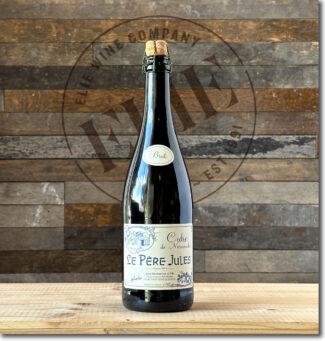 6 Cidrerie Léon Desfrièches et Fils ‘Le Père Jules’, IGP Cidre de Normandie ($16) (750 ml, Effervescent Brut – 5% abv)
6 Cidrerie Léon Desfrièches et Fils ‘Le Père Jules’, IGP Cidre de Normandie ($16) (750 ml, Effervescent Brut – 5% abv)
Very mature apple notes do homage to the Father Jules, showing white flowers and honey. Upfront in the first mouth, it develops an earthy, rich and fruity bouquet with interesting tannins for a long aftertaste.
- - -
Posted on 2024.06.26 in Cidre, France, Wine-Aid Packages
Featured Wines
- Notebook: A’Boudt Town
- Saturday Sips Wines
- Saturday Sips Review Club
- The Champagne Society
- Wine-Aid Packages
Wine Regions
Grape Varieties
Aglianico, Albarino, Albarín Tinto, Albillo, Aleatico, Alicante Bouschet, Aligote, Altesse, Arcos, Aubun, Auxerrois, Barbarossa, Beaune, Biancu Gentile, Bonarda, bourboulenc, Cabernet Sauvignon, Caladoc, Carignan, Chablis, Chenin Blanc, Cinsault, Clairette, Cortese, Corvinone, Cot, Counoise, Dolcetto, Fiano, folle Blanche, Frappato, Fumin, Gamay, Garganega, Garnacha Tintorera, Godello, Graciano, Grenache, Grenache Blanc, Grolleau, Groppello, Jacquère, Lladoner Pelut, Maconnais, Malbec, Malvasia, Malvasia Nera, manseng, Marcelan, Marselan, Marzemino, Melon de Bourgogne, Mencía, Merlot, Mondeuse, Montepulciano, Montònega, Mourv, Mourvèdre, Muscadelle, Muscat, Natural, Nebbiolo, Nero d'Avola, Niellucciu, Palomino, Patrimonio, Pecorino, Pedro Ximénez, Persan, Petit Verdot, Pineau d'Aunis, Pinot Auxerrois, Pouilly Fuisse, Pouilly Loche, Poulsard, Riesling, Rondinella, Rose, Rousanne, Roussanne, Sagrantino, Sangiovese, Sauvignon, Sciacarellu, Serine, Souson, Sylvaner, Syrah, Tannat, Tempranillo, Teroldego, Timorasso, Treixadura, trepat, Trousseau, Ugni Blanc, Viognier, Viura, Xarel-loWines & Events by Date
- September 2025
- August 2025
- July 2025
- June 2025
- May 2025
- April 2025
- March 2025
- February 2025
- January 2025
- December 2024
- November 2024
- October 2024
- September 2024
- August 2024
- July 2024
- June 2024
- May 2024
- April 2024
- March 2024
- February 2024
- January 2024
- December 2023
- November 2023
- October 2023
- September 2023
- August 2023
- July 2023
- June 2023
- May 2023
- April 2023
- March 2023
- February 2023
- January 2023
- December 2022
- November 2022
- October 2022
- September 2022
- August 2022
- July 2022
- June 2022
- May 2022
- April 2022
- March 2022
- February 2022
- January 2022
- December 2021
- November 2021
- October 2021
- September 2021
- August 2021
- July 2021
- June 2021
- May 2021
- April 2021
- March 2021
- February 2021
- January 2021
- December 2020
- November 2020
- October 2020
- September 2020
- August 2020
- July 2020
- June 2020
- May 2020
- April 2020
- March 2020
- February 2020
- January 2020
- December 2019
- November 2019
- October 2019
- September 2019
- August 2019
- July 2019
- June 2019
- May 2019
- April 2019
- March 2019
- February 2019
- January 2019
- December 2018
- November 2018
- October 2018
- September 2018
- August 2018
- July 2018
- June 2018
- May 2018
- April 2018
- March 2018
- February 2018
- January 2018
- December 2017
- November 2017
- October 2017
- September 2017
- August 2017
- July 2017
- June 2017
- May 2017
- April 2017
- March 2017
- February 2017
- January 2017
- December 2016
- November 2016
- October 2016
- September 2016
- August 2016
- July 2016
- June 2016
- May 2016
- April 2016
- March 2016
- February 2016
- January 2016
- December 2015
- November 2015
- October 2015
- September 2015
- August 2015
- July 2015
- June 2015
- May 2015
- April 2015
- March 2015
- February 2015
- January 2015
- December 2014
- November 2014
- October 2014
- September 2014
- August 2014
- July 2014
- June 2014
- April 2014
- March 2014
- February 2014
- January 2014
- December 2013
- November 2013
- October 2013
- September 2013
- August 2013
- July 2013
- June 2013
- May 2013
- April 2013
- March 2013
- February 2013
- January 2013
- December 2012
- November 2012
- October 2012
Search
